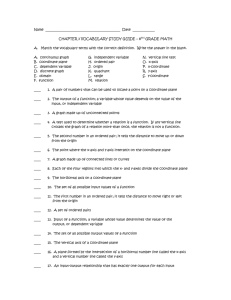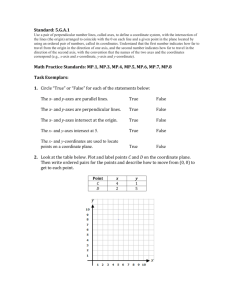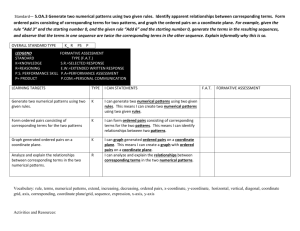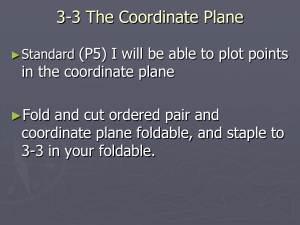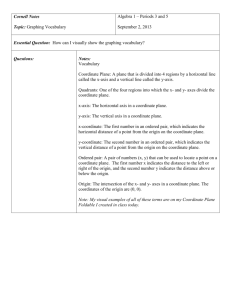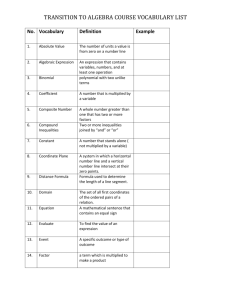5th Grade Unit 7 - VCS K
advertisement
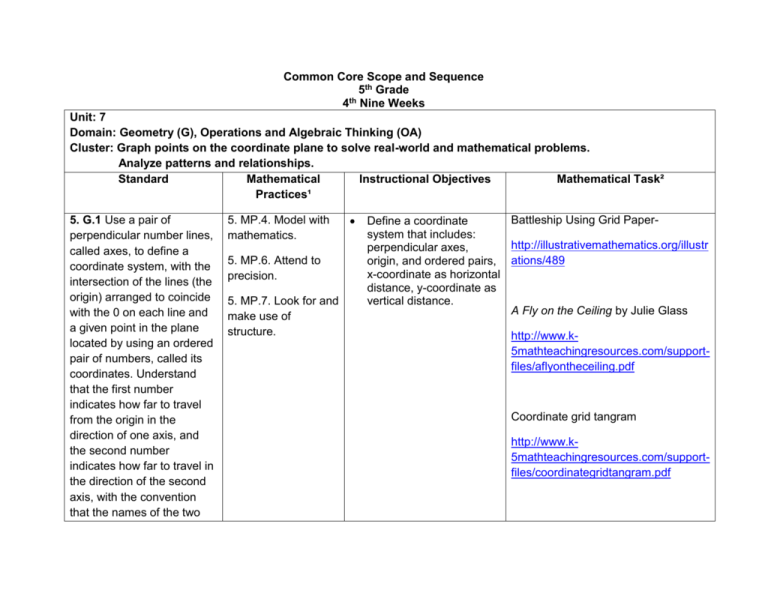
Common Core Scope and Sequence 5th Grade th 4 Nine Weeks Unit: 7 Domain: Geometry (G), Operations and Algebraic Thinking (OA) Cluster: Graph points on the coordinate plane to solve real-world and mathematical problems. Analyze patterns and relationships. Standard Mathematical Instructional Objectives Mathematical Task² Practices¹ 5. G.1 Use a pair of perpendicular number lines, called axes, to define a coordinate system, with the intersection of the lines (the origin) arranged to coincide with the 0 on each line and a given point in the plane located by using an ordered pair of numbers, called its coordinates. Understand that the first number indicates how far to travel from the origin in the direction of one axis, and the second number indicates how far to travel in the direction of the second axis, with the convention that the names of the two 5. MP.4. Model with mathematics. 5. MP.6. Attend to precision. 5. MP.7. Look for and make use of structure. Battleship Using Grid PaperDefine a coordinate system that includes: http://illustrativemathematics.org/illustr perpendicular axes, origin, and ordered pairs, ations/489 x-coordinate as horizontal distance, y-coordinate as vertical distance. A Fly on the Ceiling by Julie Glass http://www.k5mathteachingresources.com/supportfiles/aflyontheceiling.pdf Coordinate grid tangram http://www.k5mathteachingresources.com/supportfiles/coordinategridtangram.pdf axes and the coordinates correspond (e.g., x-axis and x-coordinate, y-axis and ycoordinate). Connect these points in order on the coordinate grid below: (2, 2) (2, 4) (2, 6) (2, 8) (4, 5) (6, 8) (6, 6) (6, 4) and (6, 2). What letter is formed on the grid? Emanuel draws a line segment from (1, 3) to (8, 10). He then draws a line segment from (0, 2) to (7, 9). If he wants to draw another line segment that is parallel to those two segments what points will he use? 5. G.2 Represent real world and mathematical problems by graphing points in the first quadrant of the coordinate plane, and interpret coordinate values of points in the context of the situation. 5. MP.1. Make sense of problems and persevere in solving them. 5. MP.2. Reason abstractly and quantitatively. 5. MP.4. Model with mathematics. Graph points with positive coordinates on a coordinate system. Use ordered pairs (positive only) to represent and solve real world and mathematical problems. Geometric Shapes on a Coordinate grid http://www.k5mathteachingresources.com/supportfiles/geometricshapesonthecoordinate grid.pdf 5. MP.5. Use appropriate tools strategically. 5. MP.6. Attend to precision. 5. MP.7. Look for and make use of structure. OA.5.3 Generate two numerical patterns using two given rules. Identify apparent relationships between corresponding terms. Form ordered pairs consisting of corresponding terms from the two patterns, and graph the ordered pair on a coordinate plane. For example, given the rule “Add 3” and the starting number 0, and given the rule “Add 6” and the starting number 0, generate terms in the resulting sequences, and observe that the terms in one sequence are twice the corresponding terms in 5. MP.2. Reason abstractly and quantitatively. 5. MP.7. Look for and make use of structure. Write two numerical patterns given two rules. Identify relationships between corresponding terms. Form ordered pairs consisting of corresponding terms from the two patterns. Graph ordered pairs from the two patterns on the coordinate plane. Identify features of related patterns through multiple representations. Addition on a Coordinate Plane http://www.k5mathteachingresources.com/supportfiles/additiononthecoordinateplane.pdf Ryan bought 3 movie tickets for a total of $21. Katie bought 5 movie tickets for a total of $35. Create a table to show the pattern of the prices of movie tickets. How much is 1 ticket, 2 tickets, and 4 tickets? Graph the corresponding terms as ordered pairs on a coordinate plane. What pattern do you see? Explain why. the other sequence. Explain informally why this is so. Vocabulary: coordinate plane (system), perpendicular, axes, origin, ordered pairs, coordinates, x-coordinate, y-coordinate, x-axis, y-axis, quadrant, corresponding terms, rule, sequence Explanations and Examples³: 5.G.1 Examples: Students can use a classroom size coordinate system to physically locate the coordinate point (5, 3) by starting at the origin point (0,0), walking 5 units along the x axis to find the first number in the pair (5), and then walking up 3 units for the second number in the pair (3). The ordered pair names a point in the plane. Graph and label the points below in a coordinate system. o A (0, 0) o B (5, 1) o C (0, 6) o D (2.5, 6) o E (6, 2) o F (4, 1) G (3, 0) 5.G.2 Examples: Sara has saved $20. She earns $8 for each hour she works. o If Sara saves all of her money, how much will she have after working 3 hours? 5 hours? 10 hours? o Create a graph that shows the relationship between the hours Sara worked and the amount of money she has saved. o What other information do you know from analyzing the graph? Use the graph below to determine how much money Jack makes after working exactly 9 hours. 5.OA.3 Example: Use the rule “add 3” to write a sequence of numbers. Starting with a 0, students write 0, 3, 6, 9, 12, . . . Use the rule “add 6” to write a sequence of numbers. Starting with 0, students write 0, 6, 12, 18, 24, . . . After comparing these two sequences, the students notice that each term in the second sequence is twice the corresponding terms of the first sequence. One way they justify this is by describing the patterns of the terms. Their justification may include some mathematical notation (See example below). A student may explain that both sequences start with zero and to generate each term of the second sequence he/she added 6, which is twice as much as was added to produce the terms in the first sequence. Students may also use the distributive property to describe the relationship between the two numerical patterns by reasoning that 6 + 6 + 6 = 2 (3 + 3 + 3). 0, 0, +3 3, +6 6, +3 6, +6 12, +3 9, +618, +312, +6 ... 24, . . . Once students can describe that the second sequence of numbers is twice the corresponding terms of the first sequence, the terms can be written in ordered pairs and then graphed on a coordinate grid. They should recognize that each point on the graph represents two quantities in which the second quantity is twice the first quantity. Ordered pairs (0, 0) (3, 6) (6, 12) (9, 18) (12, 24) Performance Task: www.uen.org² The local department store has recently released its information regarding video game sales over the last nine months. In the first month they sold 75 games. In the next month they sold 72. In the third month they sold 60, and in the fourth they sold 42. In the fifth month they sold 45, in the sixth they sold 38, in the seventh they sold 56, in the eighth they sold 62, and in the ninth they sold 79. Organize this data in a chart and then plot it on a coordinate grid to help the store understand their video game sales. -orhttp://www.dpi.state.nc.us⁴ Sara has saved $20. She earns $8 for each hour she works. If Sara saves all of her money, how much will she have after working 3 hours? 5 hours? 10 hours? Create a graph that shows the relationship between the hours Sara worked and the amount of money she has saved. What other information do you know from analyzing the graph? Use the graph below to determine how much money Jack makes after working exactly 9 hours.


